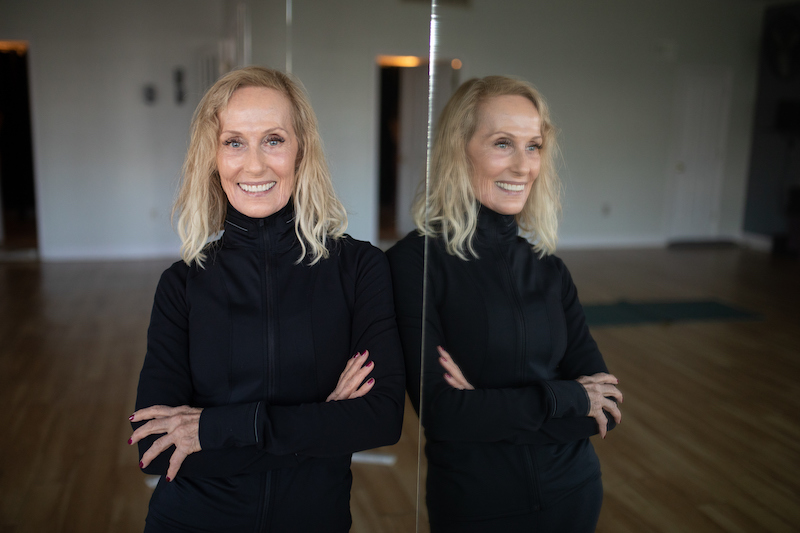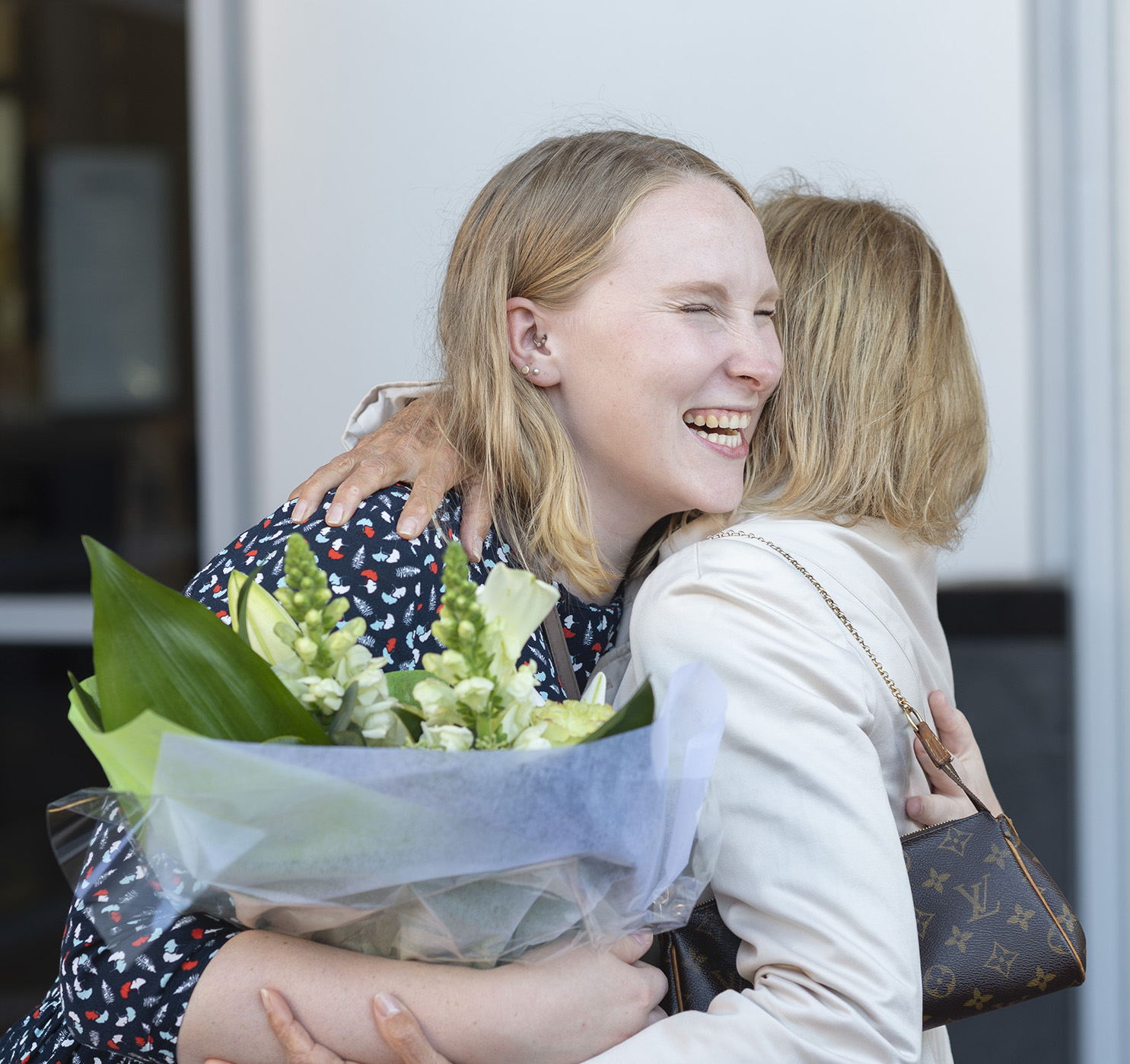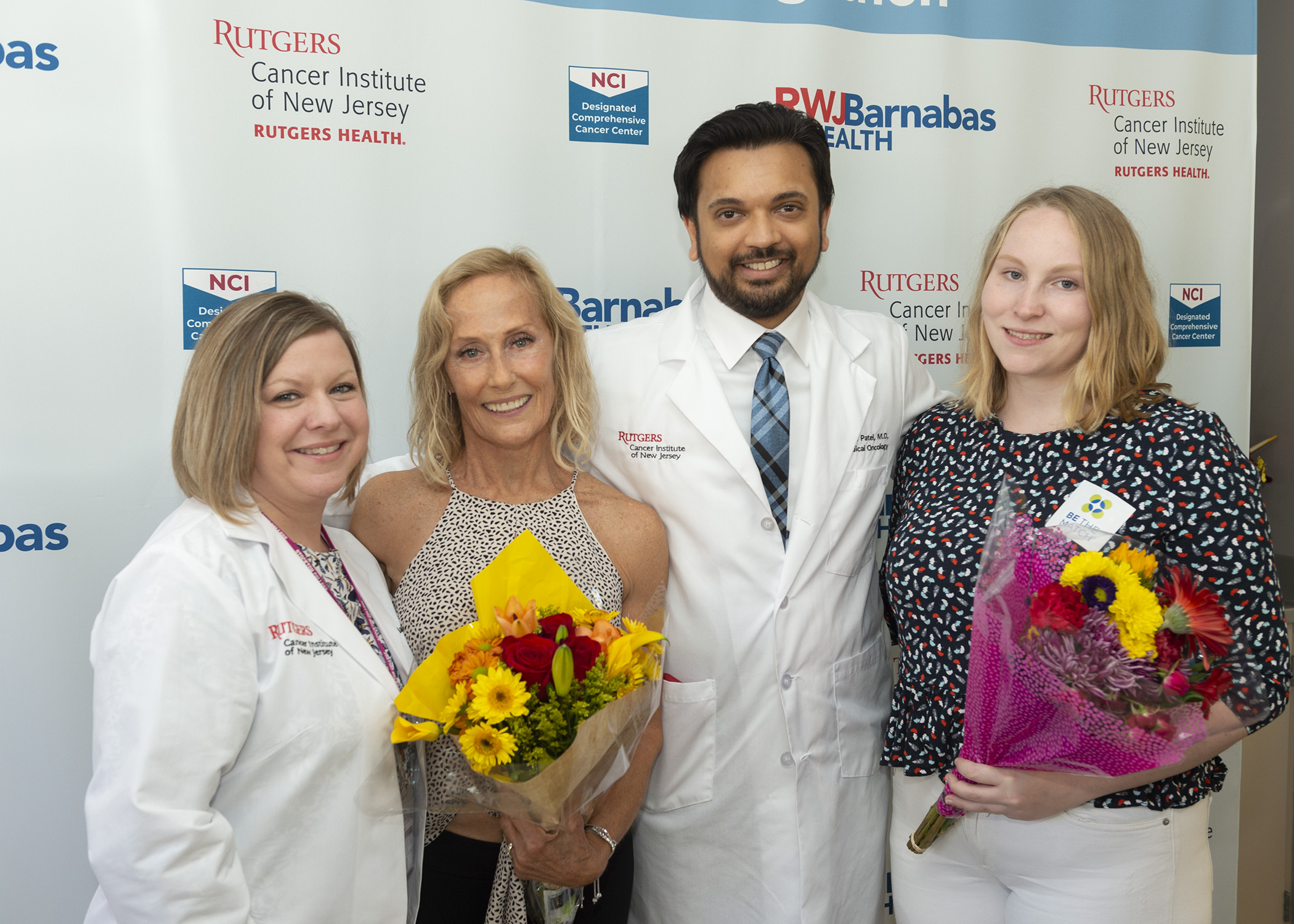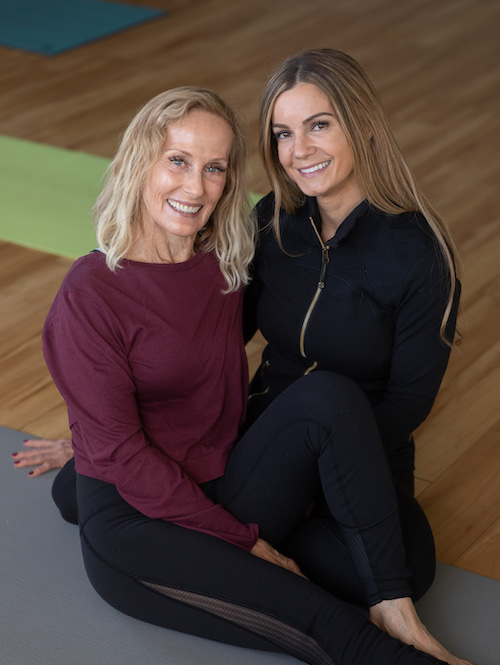Story by Maryann Brinley View the complete magazine | Subscribe to Cancer Connection
See the full video component of Lael's story
View more patient stories at cinj.org/patientstories
It’s a gorgeous day on the boardwalk in Bradley Beach and to look at the two women, smiling happily at being together, you would never guess that they had met in person for the very first time just three days before. They exhibit a strong physical and emotional connection – a bond worth life itself.
“I feel as if I’m with my daughter or my niece,” Lael McGrath admits. The 68-year-old wife, mother of two, and grandmother of six, owes her life to Wiebke Rudolph, a 21-year-old recent college graduate from Kassel, Germany. Rudolph donated her stem cells anonymously to McGrath after the retired second grade teacher from Toms River was diagnosed with life-threatening acute leukemia in 2016. Both have looked forward to this meeting for more than two years.
“To have a donor and patient together like this is truly remarkable,” according to Vimal Patel, MD, a hematologist/oncologist in the Blood and Marrow Transplant Program at Rutgers Cancer Institute of New Jersey and Robert Wood Johnson University Hospital (RWJUH) New Brunswick, an RWJBarnabas Health facility. “I’ve been attending here for seven years and this is the reason I went into my field: to see moments like this.” He first met McGrath back in August 2016 when she presented with fevers, night sweats, a rash on her back and blood work showing that she was anemic (having low hemoglobin) and had a low white blood cell count.

Lael McGrath
Credit: John O'Boyle
Dr. Patel, who is also an associate professor of medicine at Rutgers Robert Wood Johnson Medical School, has been by her side since then, along with a vast team of specialists. From bone marrow transplant physicians, stem cell coordinators, advance practice nurses, RNs, social workers, administrative personnel and others, Patel notes, “We are all committed to one goal: to get the patient better. These patients aren’t numbers. They actually become part of our family.”
Smiling across at Rudolph today, McGrath goes back to the beginning of her incredible journey to cancer remission. A runner for more than 40 years, she also practices yoga regularly and explains, “I was always totally dedicated to health and fitness so I may have been able to recognize sooner than someone else that something wasn’t right.” In that summer of 2016, she couldn’t run more than a block without having to stop to walk. “I remember thinking, ‘What the heck is this?’ And then I got the flu, in the summer! I even thought I might still be going through menopause,” she laughs. “The sweats were so bad at night I had to change the sheets.” A friend was diagnosed with Lyme disease “and her symptoms sounded like mine,” she recalls, “so I made an appointment with an infectious disease specialist and while there, his phlebotomist took blood samples.”

Four thousand miles away, Wiebke Rudolph (above, left) was notified that she matched a patient in dire need. She never thought twice about backing out. After all was said and done, both women agree, "It was a miracle."
Credit: Daniel DellaPiazza
Within 24 hours, this doctor called back to explain that he had sent the blood test results to a hematologist who wanted her in his office that day.
“Why?” McGrath asked. “My heart was pounding but he wasn’t about to say anything on the telephone that he may have been thinking professionally. He kept insisting that I get to this other doctor immediately.”
Sitting in that doctor’s office where the sign read ‘Hematologist/Oncologist,’ McGrath remembers thinking: What am I doing here?
“You don’t think I have Lyme disease?” she asked.
“I think you have leukemia,” was the answer. “And I think you need to go to Rutgers Cancer Institute of New Jersey in New Brunswick right now. Today.”
“It was like a bad dream,” she recalls. “I stood up from my chair, walked over to my husband Herb who was sitting two feet away and fell into his lap.” McGrath’s immune system was so suppressed that she was in a life-threatening situation. Within three days she would be admitted to RWJUH where she would spend the next seven weeks undergoing chemotherapy.
In the hospital, under Patel’s care her treatment involved the use of combination chemotherapy designed to get her into remission. The exact diagnosis would eventually be acute undifferentiated leukemia, a type that has features of both acute myeloid leukemia and acute lymphoid leukemia. The first course of chemotherapy didn’t work because her leukemia was so aggressive, according to Patel. “The specific mutations that we identified in her leukemia were high risk in nature so we knew that chemotherapy alone would not keep her in remission. We needed immune therapy in the form of an allogeneic stem cell transplant.”
In a bone marrow transplant, cells can be used from your own body, known as an autologous transplant, or when taken from a donor, called allogeneic. Patel explains, “This is a procedure where the patient’s diseased marrow is replaced with a donor’s blood stem cells. It allows for normal blood formation and also provides a new immune system to help eliminate the leukemia. It also has the potential for a cure.”
Though McGrath is one of five living siblings, no one in her family matched closely enough to be a donor. Bone marrow transplant coordinator Mary Kate McGrath, MSN, RN, APN, BMTCN, OCN, (no relation to Lael), explains, “I knew about Lael and her diagnosis immediately because the leukemia doctors notify the coordinators right away when a patient with a high-risk disease is admitted. Her DNA testing, also known as HLA typing, was done then. Once those results were available, I was able to run them through the National Marrow Donor Program (NMDP) registry and identify potential matched donors.” HLA, or human leukocyte antigens, are proteins or markers found in most cells in the body and the immune system uses them to recognize which cells don’t belong there.
“Picking a donor is a multi-factorial process, taking into consideration sex, blood type, pregnancy history, ethnicity, and availability,” the coordinator points out. “Within two months of Lael’s diagnosis, we identified three people on the registry who were ultimately tested but Wiebke was perfect.” Rudolph, her unidentified donor, was in fact, a 10 out of 10 in the HLA typing, according to Lael McGrath. On the ‘Be The Match’ registry, Patel points out, “There are 33 million people worldwide willing to be donors. Up to 70 percent of the time, we don’t find matches in the family so we go to this registry.”

Bone marrow transplant coordinator Mary Kate McGrath, MSN, RN, APN, BMTCN, OCN, (above, left), with (left to right), Lael McGrath, Vimal Patel, MD, and Wiebke Rudolph at a special event over the summer that celebrated donor and recipient meeting for the first time.
Credit: Daniel DellaPiazza
Four thousand miles away in Germany, Rudolph was notified that she matched a patient in dire need. She never thought twice about backing out and explains, “I think you have the right to think about that before you sign up but afterward, you can’t say no. Once I got swabbed, and then got the call, I was determined. Not that many people in Germany do this and certainly no one in my family or among my friends. But when I first heard about this, I said yes, I’m going to do it.” Peripheral blood stem cell donation is usually an outpatient procedure called apheresis that collects stem cells over a six-hour period via the peripheral blood. Rudolph admits that she did have some uncomfortable side effects to the medicine preparation given ahead of time to boost her production of blood stem cells but otherwise, she felt fine. “It all depends on how your body reacts to the medicine and I did have a reaction. It was hard but I wanted to do this.”
With the breeze blowing off the Atlantic Ocean, these two women look knowingly at one another, smile, and agree, “It was a miracle.”
All the logistics of harvesting Rudolph’s stem cells and then transporting them to America were handled by NMDP, according to Mary Kate McGrath. “I value how cohesive our team is and believe our patients are aware of this.” For example, Lael McGrath’s need for repeat blood transfusions was made possible by the RWJUH Blood Services team. “Without a robust and stable supply of blood and platelets, bone marrow and stem cell transplantation would not be an option,” explains Sally Wells, business development liaison for the blood group. “Blood products are required as part of the preparation before and then after transplant treatment.”

"I was always totally dedicated to health and fitness so I may have been able to recognize sooner that something wasn't right," says Lael McGrath (above, left), with daughter, Torrey. Thanks to her health care team at Rutgers Cancer Institute and her transplant donor, McGrath is disease-free today, and back to keeping active and fit by attending regular classes at Jersey Shore Hot Yoga in Avon.
Credit: John O'Boyle
In the hospital for so many weeks that fall and winter of 2016, Lael McGrath recalls, “It was hard. I couldn’t see my grandchildren and I had been the kind of grandmother who was with them every day. We are a very close family. I really, really missed them but all the patients there with me in the hospital had zero immune systems and we couldn’t allow children coming in from schools visiting and possibly bringing infection with them.” Her room was full of photos of her daughter Torrey, 34, son John, 41, their spouses and all six grandchildren ranging in age from 18 months to 11 years. “One day in between chemo treatments, I was allowed to go outside to the patio to be with all of them.” That gave her the boost she needed to keep going.
That time in the hospital, explains Patel, “is like pressing a reset button on the bone marrow. Patients need multiple transfusions, antibiotics and close monitoring on a daily basis.” Patel, who has always had a special interest in research focused on stem cell transplant and cancer immune therapy, adds “Many hematologic malignancies become resistant to traditional treatments and such cancers may be definitively treated by harnessing the immune system. This can be accomplished through allogeneic stem cell transplant but also through the use of innovative immuno-oncologic therapies (like bispecific antibodies, checkpoint inhibitors, and adoptive cellular therapy) available only through clinical trials that are available here at Rutgers Cancer Institute.”
As it got closer to the holidays, McGrath admits, “It was a melancholy time and rough for me.” The week of December first, going back in the hospital again, she was notified, “You are going to get the transplant and on the 16th, it happened,” she recalls. “A team walked in carrying a small cooler and within an hour, the transfusion was over. The staff called this day my second birthday. All I actually knew was that the donor was female and 19 years old.” McGrath did so well post-transplant that she was able to go home on New Year’s Day 2017.
For more than two years, she wondered about her donor. Over in Germany, Rudolph had been told that the transplant went well. Protocol and confidentiality policies don’t permit donors and patients to have direct contact with each other until at least one year has passed. In this case, the wait lasted more than two years until test results showed that her blood cells were 100 percent ‘donor.’ That eventually happened and McGrath’s blood type actually changed from O positive to A positive, now matching Rudolph’s.
Not all donors and patients meet. But there was never any doubt for either of these two women. In fact, the pair started emailing, texting and then talking to each other on Facetime right after being given each other’s contact information.
Recently, at a celebration at RWJUH, both women held bouquets of flowers and stood happily alongside one another. “If it weren’t for Wiebke, I don’t know what would have happened.”
For months, McGrath had pestered the doctors, nurses, coordinators and all the caregivers she loved and appreciated.
“Can I say I’m in remission?”
Recently, she got the answer she has been waiting to hear. “Lael McGrath is a truly remarkable woman,” says Patel. “She has been through so much and is disease-free. It looks like nothing ever happened to her and I am so happy to have guided her down this path as her transplant physician. I love making this difference: to meet someone when they are in a very dark part of their life and to change that. It’s an amazing feeling.”
Match Up
If you choose to get your cheek swabbed and put yourself on the Be The Match registry, you can become part of the world’s largest and most diverse donor registry with more than 19 million potential bone marrow donors.
According to Be The Match calculations, every three minutes someone like Lael McGrath is diagnosed with a blood cancer and like 70 percent of those patients, there is no fully matched donor in the family. She wouldn’t have had her happy ending if it weren’t for the stranger across the Atlantic Ocean who took a leap of heroic chance.
It’s easy to sign up: Go to Join.bethematch.org/RWJ. Or call 1-800-MARROW-2. You can also help by donating blood and platelets at the RWJUH Blood Donor Center. For information, call 732-235-8100, Ext. 221 or book an appointment online at rwjuhdonorclub.org.

